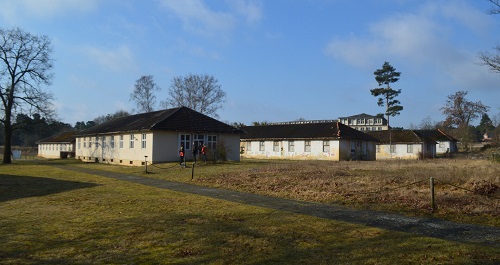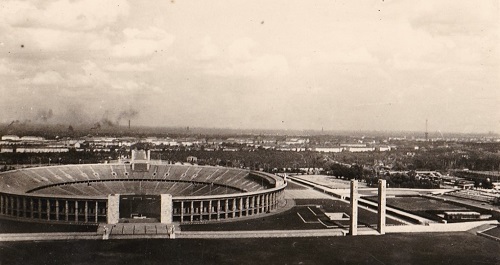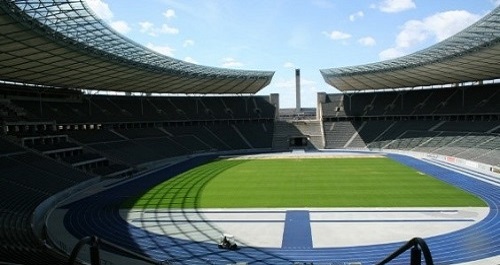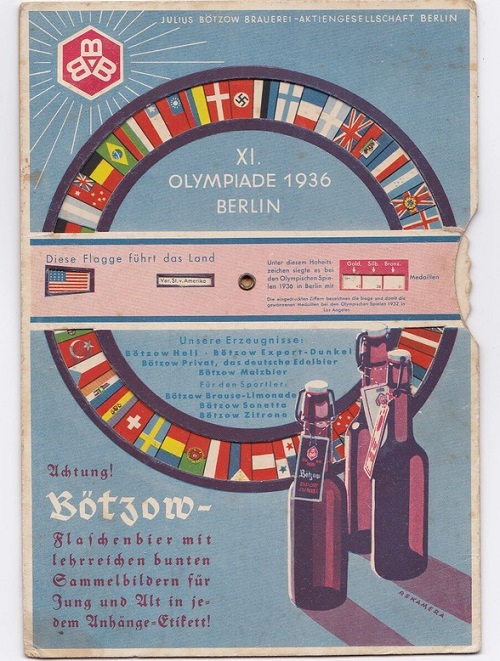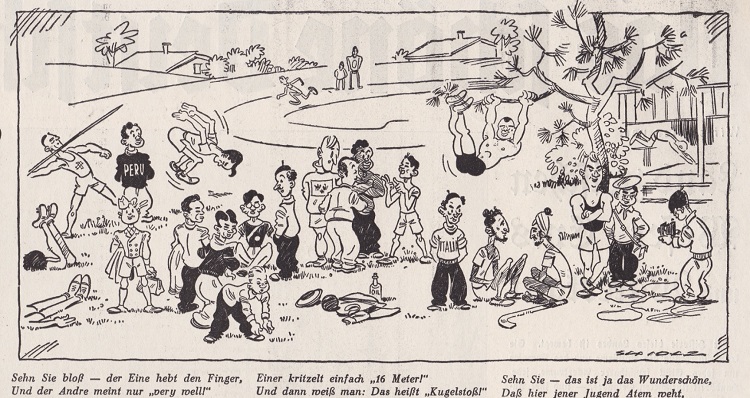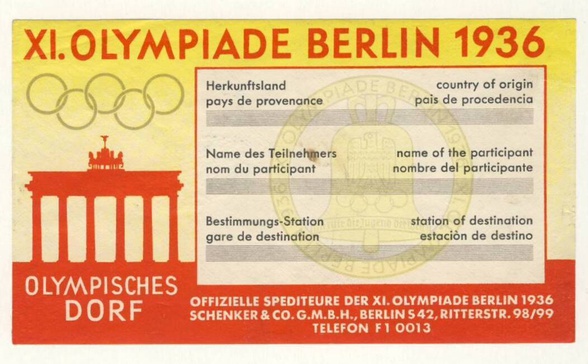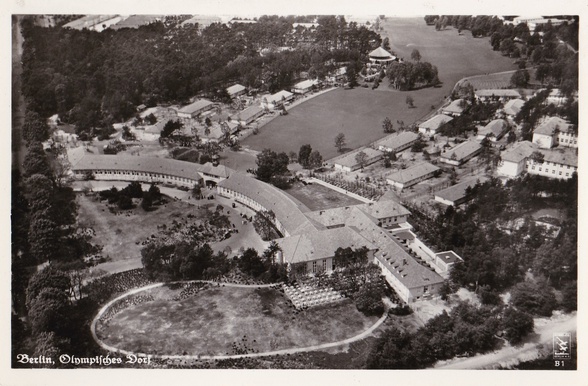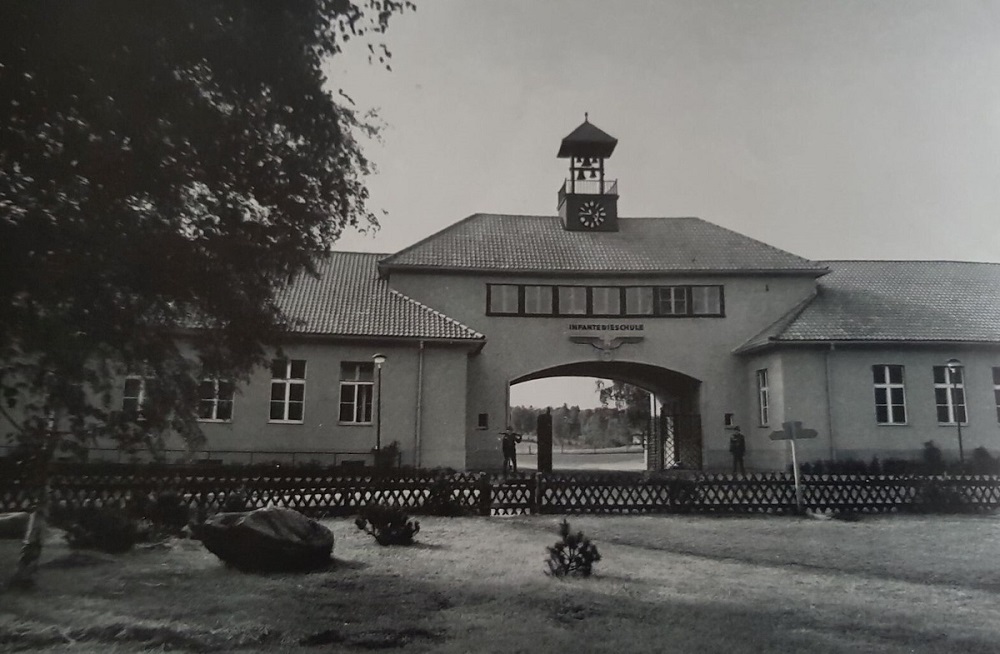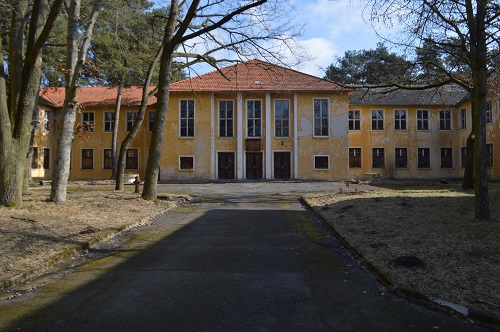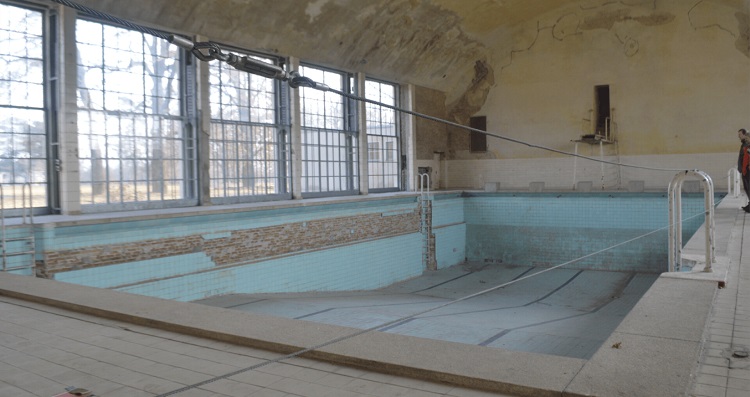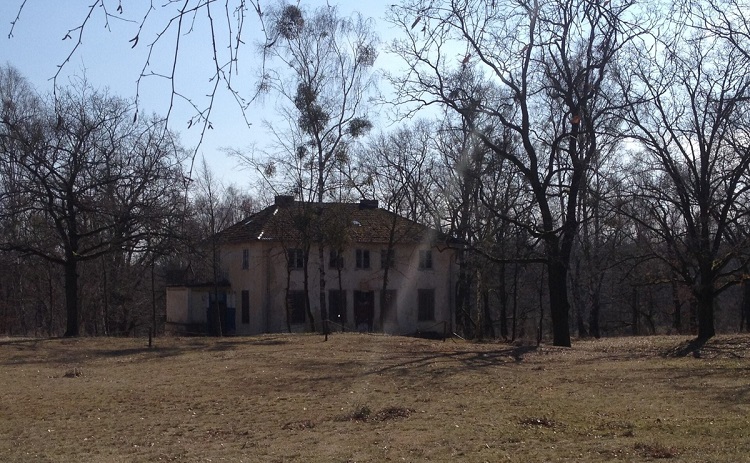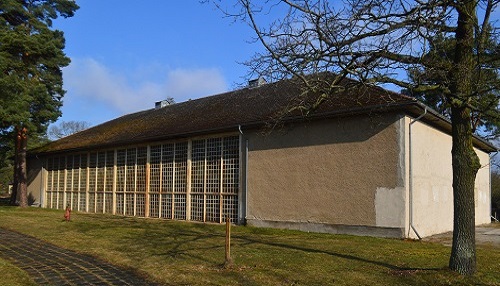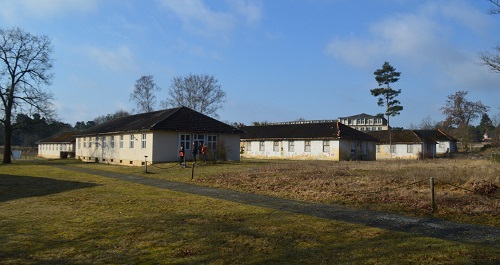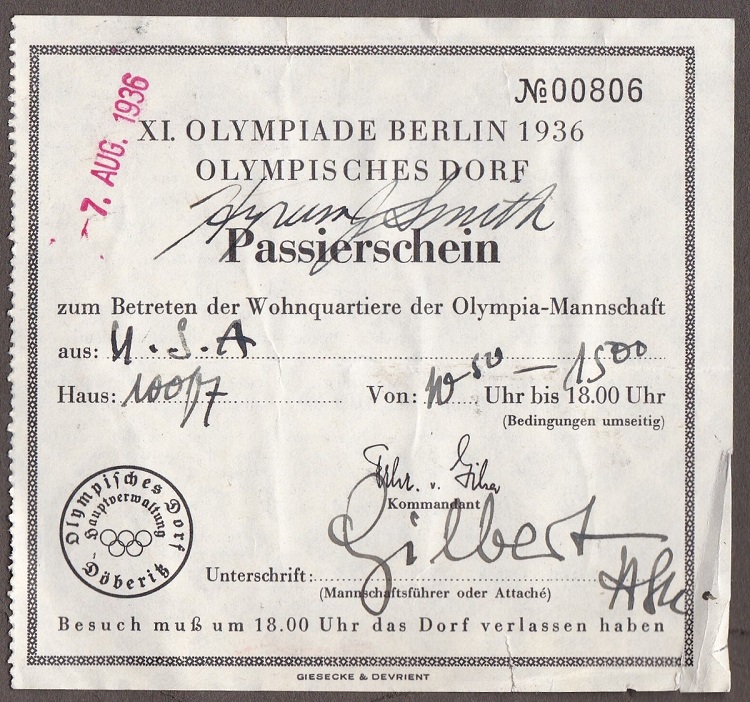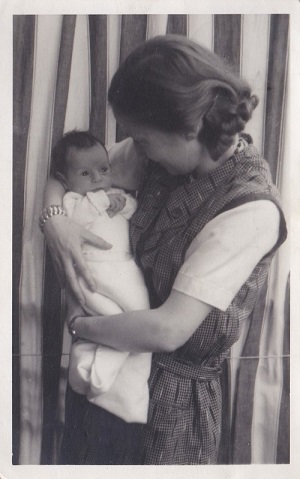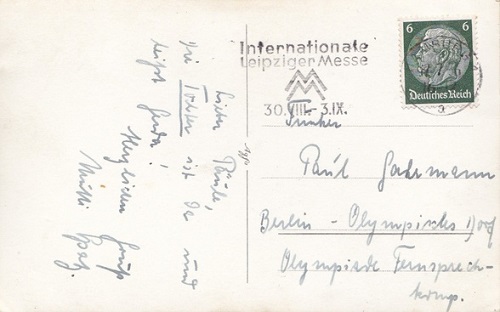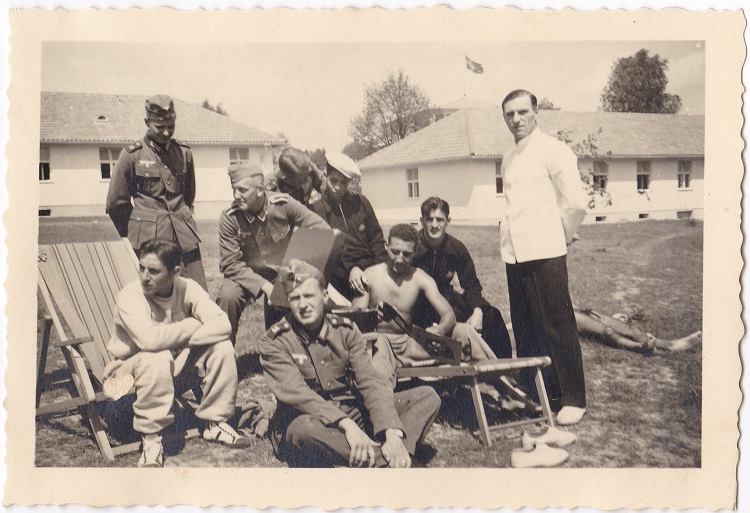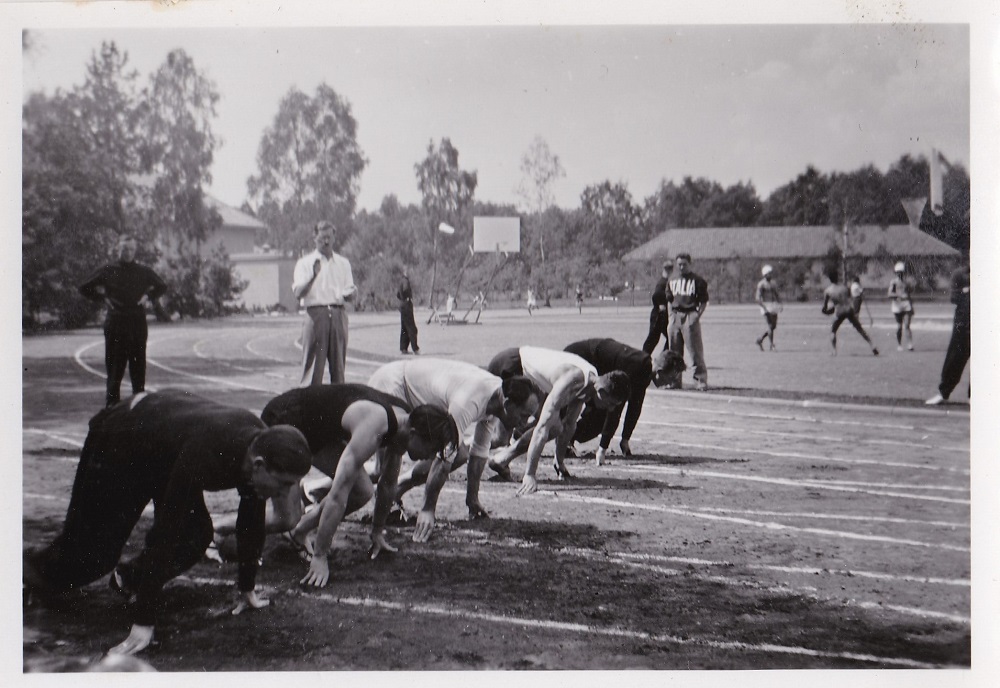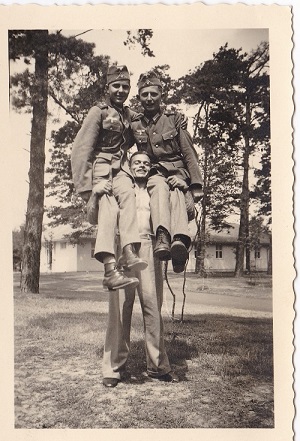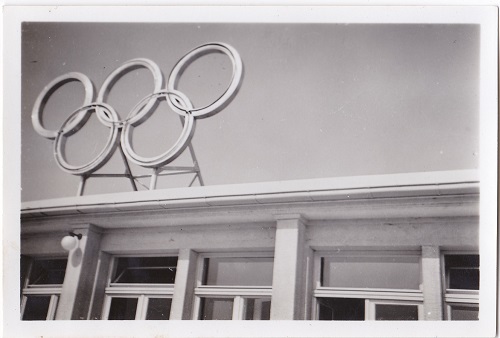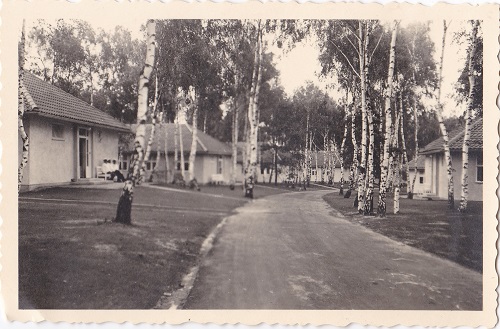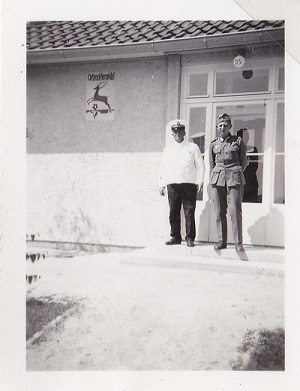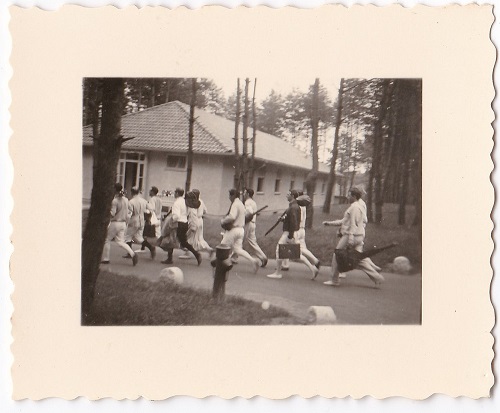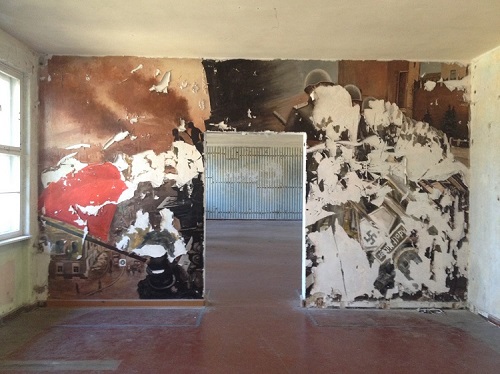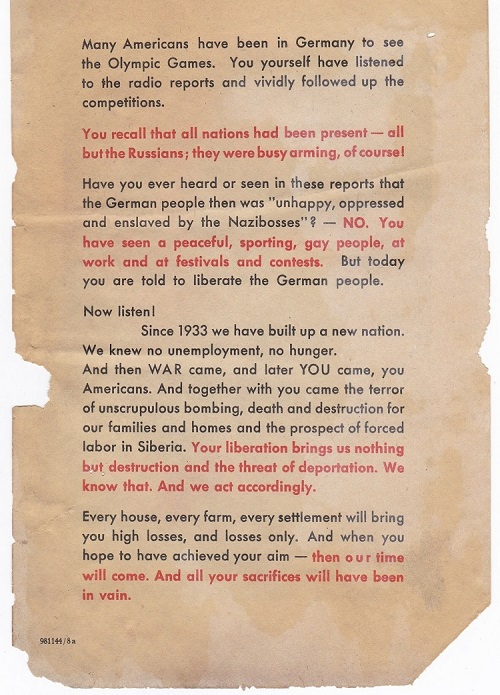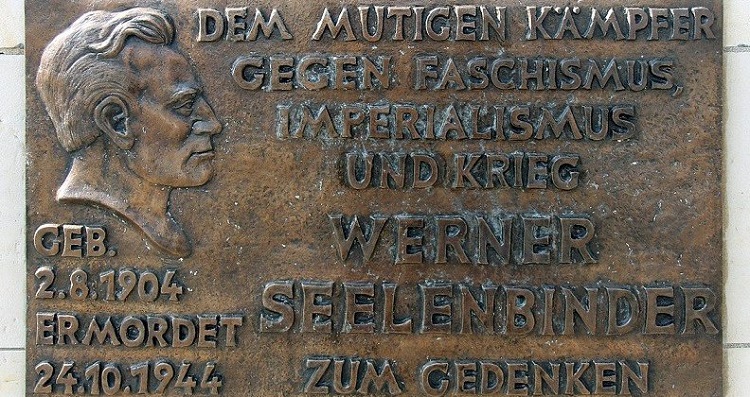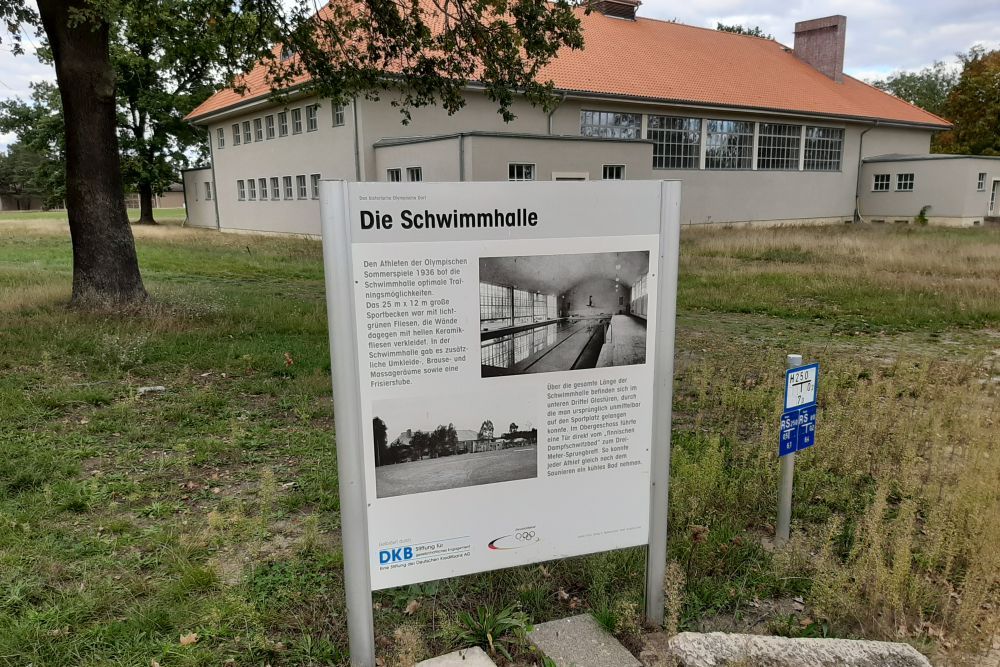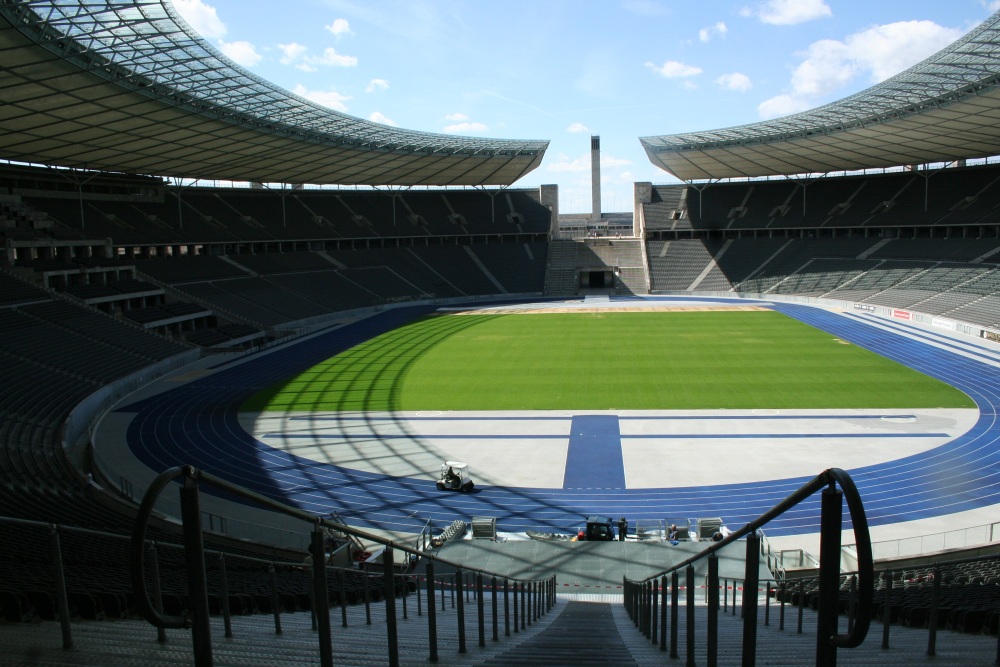Preface
The original Dutch text of this article was written by Maurice Laarman and was taken, along with most of the images, from the former website www.olympischdorp1936.nl. All English text in this article is based on the original Dutch version, revised by George Möller, and was edited by Arnold Palthe on request of the editor-in-chief of TracesOfWar.
"Never before were the Olympic athletes more comfortably and adequately accommodated."
The Olympic Games of 1936 are of course known to everyone. Almost all history books about the Second World War mention the Olympic Games, three years after Adolf Hitler became Chancellor, as a true example of deception. The world was pulled the wool over the eyes with regards to the true intentions of the regime.
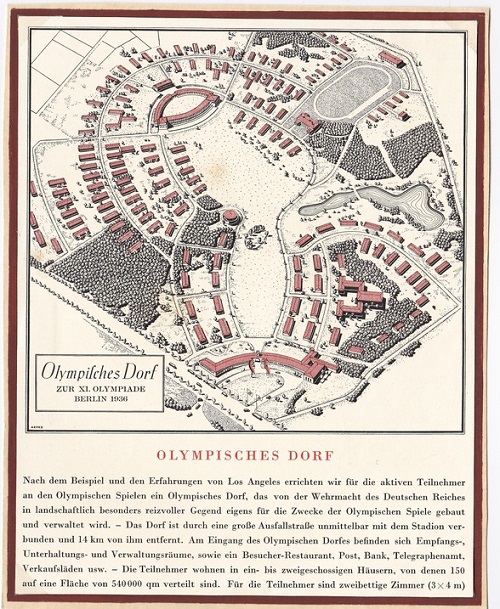
A map of the village. Two things are remarkable here. First, we do not see the entire village. The 1,180 athletes from Japan, Hungary, Brazil, Poland, Denmark, Czechoslovakia, Romania and Germany were housed in adjacent 22. Flak regiment barracks because there was not enough space in the village. The barracks are not on the drawing. Secondly, the map is rotated approximately 30° northwest. Apparently this gave a better picture. Source: M.S. Laarman Collection
The Olympic stadium is still there and also still being used: the Hertha BSC Berlin football club uses it as its home base. Although it has been modernized and now has a roof, it is still just as impressive. Tourists also know where to find the stadium complex, with around 300,000 visitors every year.
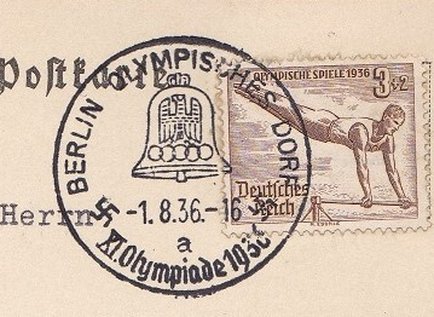
Stamp on a postcard, specially put in the village for collectors. In those years, collecting postal items with special stamps was very popular. You could buy a postal item or stamp sheet, or individual stamps with that stamp at a specific location. The village was such a location during the Olympic Games. Source: M.S. Laarman Collection
The Olympic village on the other hand, the place where the male athletes were housed during the Games, led a languishing existence all those years and is not well-known. The village was built between 1934 and 1936 on the Truppenübungsplatz (military training area) Döberitz near Berlin.In this article we want to show more about the background, history and future of the village.
1936 Olympic Games
Introduction
The 1936 Olympic Games in Berlin have a long history. In 1931 it became clear that Berlin could organize the Olympic Games in 1936. That would not be the first time because Germany was also awarded the Games in 1916. There was already a stadium (the Deutsche Stadion, designed by architect Otto March) built in the Grunewald district, but the First World War stopped normal life and therefore also the Olympic Games. At the upcoming Games in 1920 and then in 1924, Germany was excluded from participation. In 1928 in Amsterdam, German athletes participated again for the first time since 1912.
In the meantime, something political happened in Germany that would change world history. On July 31, 1932, one day after the opening of the Games in Los Angeles, the NSDAP received more than a third of the votes in the Reichstag election. The success of this party ultimately resulted in Adolf Hitler being appointed Reich Chancellor on January 30. That in itself was worrying for those who were organizing the Games in Germany. The NSDAP had previously been negative about the Games. This was far too international and multicultural oriented to their liking. When they were a small splinter party, that criticism didn't matter, but now that they were the biggest party, the Games could be at risk. Hitler was not enthusiastic in the beginning either. Yet, after many conversations with the new rulers, with Goebbels leading the way, it was recognized that the Games were an excellent opportunity to show the best side of the Third Reich to the world to get foreign currency and to give people a job during the construction of the stadium complex, village and other activities. Furthermore, it was of course an advantage that the Games would motivate the Germans to stay fit and healthy: ideal if you also want fit soldiers.
It was planned to modernize the existing Deutsche Stadium and use it for the Games. When Hitler visited the complex in October 1933, those plans were canceled. In his opinion, the stadium could not represent the New Germany. Instead, a large, modern, elegant and monumental stadium complex had to be built. Architect Werner March and his brother Walter were given this task. The family was therefore closely connected to the Olympic Games, because father Otto had designed the old stadium.
The construction of the 0.5 square miles Reichssportfeld soon began; in April 1934 the first spade went into the ground. The new stadium would accommodate 100,000 spectators. In comparison: the 'Kuip' stadium in Rotterdam was opened in 1937 and now has a capacity of 51,117 spectators, at the opening it was 65,000.
Boycott?
The Summer Games took place from August 1 to August 16, 1936. In total 49 countries participated, with a total of 3,961 athletes. That was a new record. However, it was close to becoming a fiasco. Then, and certainly now, the Games were seen as an instrument of the National Socialists to put Germany in a positive light. That of course happens with every edition of the Olympic Games, even nowadays. But at the same time there was a lot going on in Hitler's Germany. Since he came to power three years earlier, there was more nationalism, less freedom, more dictatorship and especially persecution of dissenters, Gypsies and Jews. That was also noticed by the rest of the world, which looked with worry and suspicion at what was happening in Germany. There was a lot of discussion and protest against the Games. It was a close call or a number of countries, including the USA, would have boycotted the Games.
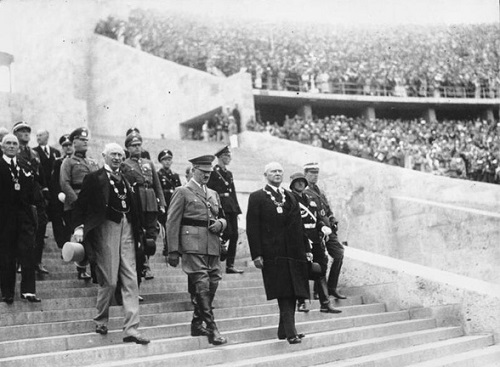
Opening of the XI Olympic Games. Chancellor Adolf Hitler with members of the national and international Olympic committee on the stairs of the stadium. Source: Bundesarchiv, Bild 183-G00372 / CC-BY-SA 3.0
Not only because of the discrimination that reared its head in Germany, but also because of the violation of the Locarno Treaty by Germany, a boycott was imminent. In this treaty, a result of the peace of Versailles after the First World War, new borders of several European countries were established. It also stated that the Rhineland, the industrial area adjacent to the Netherlands, Belgium, Luxembourg and France, must be and remain demilitarized. This as a buffer against a possible attack from Germany towards France. From 1923 to 1930 it was also occupied by the Allies to enforce German reparations.

Entry ticket to the hockey match between India and the United States. India won 7-0. Source: M.S. Laarman Collection
However, after the Allied forces left in 1930, Hitler decided that the area should belong to Germany once again. The Wehrmacht moved into the Rhineland. This happened on March 7, 1936, only a few months before the Olympics. England and France did little about this. There was no military action, only protest letters were sent. History could have run different course if it had. At the time, Germany was not strong enough, economically and militarily, to withstand any prolonged military action. At the same time there was the threatening civil war in Spain, so it was quite a flammable situation in the world. Perhaps that is also a reason that the Games of 1936 could become a success. The world wanted to believe that people could live in peace with each other.
Definitielijst
- dictatorship
- A form of government where the power in a country is in the hands of one person, the dictator. Originally a Roman regime in case of an emergency where total power would rest with one person during six months in order to face a crisis.
- First World War
- Took place from 1914 till 1918 and is also named The Great War. The conflict started because of increased nationalism, militarism and neo-colonialism in Europe. Two alliances battled one another during the 4-year war, which after a dynamic start, resulted into static trench warfare. The belligerents were the Triple Alliance (consisting of Great-Britain, France, and Russia; later enlarged by Italy and the USA, amongst others) on the one hand and the Central Powers (consisting of Germany, Austria-Hungary, Bulgaria and the Ottoman empire) on the other hand. The war was characterized by the huge number of casualties and the use of many new weapons (flamethrowers, aircraft, poison gas, tanks). The war ended in 1918 when Germany and its allies surrendered unconditionally.
- Jews
- Middle Eastern people with own religion that lived in Palestine. They distinguished themselves by their strong monotheism and the strict observance of the Law and tradition. During World War 2 the Jewish people were ruthlessly persecuted and annihilated by the German Nazis. . An estimated 6,000,000 Jews were exterminated.
- nationalism
- The pursuit of a people to become politically independence or securing such independence.
- Reich Chancellor
- Name of German head of state. From 1933 till 1945 Adolf Hitler was Reich chancellor of Germany.
- Rhineland
- German-speaking demilitarized area on the right bank of the Rhine which was occupied by Adolf Hitler in 1936 after World War 1.
- Wehrmacht
- German armed military forces, divided in ground forces, air force and navy.
Construction
Simultaneously with the construction of the stadium complex, the construction of the Olympic village began. This was also designed by the brothers Werner and Walter March. Furthermore, the architect Dr. H.C. Steinmetz, who died shortly after the completion of the village and stadium was part of the team. The 'Landschaftsgestaltung' (landscaping) was done by Heinrich Wiepking-Jürgensman.
When the village was finished, it was opened to the public. From May 1 to June 15, 1936, approximately 370,000 people were able to admire the village. On June 10, the village was ceremonially handed over from the Wehrmacht to the IOC. The official opening with Hitler's visit to the village was on June 17. Three days later the first guests arrived: Japanese marathon runners.
The history of the Olympic village phenomenon actually does not go that far back. In 1932, Los Angeles had the first Olympic village when small wooden huts were constructed. Nowadays nothing is left of that village, it was demolished immediately after the Games. It was the inspiration for Germany to do it bigger and better. In 1932 there were 1,300 participants from 37 countries, in 1936 there would be 3,963 from 49 countries. In order to accommodate the athletes, a large-scale logistics and housing operation was required.
In fact, in 1936 people in Berlin did the same thing they do today: build as much as possible with the prospect of a later use in mind. Anyone who sees the photos of the many abandoned and unused Olympic stadiums worldwide knows that things don't always work out that way, and billions have been wasted on the construction of what will later be useless buildings.
The Olympic villages of the past decades are often buildings that were built for the Games, but are arranged in such a way that they can be turned into a normal residential area or apartment towers after some adjustments. That was, for example, the case in London, 2012, where the East Village residential area, designed for the Games with 17,320 beds for 10,000 athletes and officials, could be easily adjusted after the Games to create 2,818 homes. A good example of how costs can be reduced.

Döberitz-Elsgrund, Kaserne Flak. Rgt. 22. When it turned out that there were too few accommodations, the neighboring Luftwaffe barracks were quickly refurbished and made suitable for athletes and the Nord-Deutsche Lloyd employees working in the restaurant of the village. Source: M.S. Laarman Collection
Initially, it was intended from a financial point of view to house the athletes in barracks of the 22. Flak Regiment, nowadays apartments, and the Löwen-Adler barracks located further to the south in Döberitz. When more money became available, it was decided to build a completely new village. After the Games, it would be a great new barracks complex and hospital. There is not much difference in accommodating athletes or accommodating soldiers. That is why the design immediately took into account the reuse of the buildings. In addition, the village was also in a military training area, the Döberitzer Moor, with several barracks and training grounds a stone's throw away.
The village is a unique location in many ways. German history becomes visible there. What happened to Germany on a large scale, is emulated on a smaller scale in the village. It is the only place where you see marching Wehrmacht soldiers in stone relief on the wall in the Hindenburghaus and a drawing by Lenin on the other side. This clearly reflects the irony of German history, from pompous display of power at the time of the Wehrmacht to occupation by an enemy regime. And then precisely by one of the countries that was attacked by the Wehrmacht and also caused the fall of the Third Reich. Moreover, the Russians did not participate in the 1936 Olympic Games. They entered for the first time in 1952.
Definitielijst
- Flak
- Flieger-/Flugabwehrkanone. German anti-aircraft guns.
- Regiment
- Part of a division. A division divided into a number of regiments. In the army traditionally the name of the major organised unit of one type of weapon.
- Wehrmacht
- German armed military forces, divided in ground forces, air force and navy.
Buildings
Restaurant – Speisehaus der Nationen
The elliptical Speisehaus der Nationen (dining room of the nations) lived up to its name. There were forty dining rooms in which the different countries could have their meals. Previous Games had shown that each country is used to its own kitchen. A Thai athlete was not waiting for Bratwursten, and a German not on spiced Thai dishes. There were 200 chefs from the shipping company Norddeutschen Lloyd (NDL) who were able to provide each country with dishes that matched what they were used to. Furthermore, the crews could also bring their own cook. There were two large dining rooms with room for 150 people each on the ground floor and smaller dining rooms on the two floors above. This also meant that some larger countries had to eat divided into smaller groups. The smaller countries were combined in certain halls.
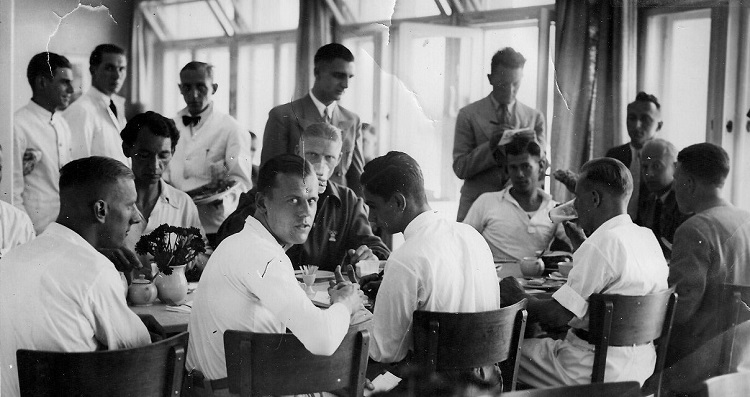
Dutch athletes, including Frans Jutte, Jo Moerman and Hans Geul, in the restaurant. The player in the middle, with a glass to his mouth, wears a pin on his lapel. Such pins were sold as a souvenir and are nowadays also fairly easy to find. Source: Atletiekhistorici.nl
The NDL took care of the whole, also in terms of purchasing and issuing food. Of course, they were vastly experienced in this, with their ships with a mixed staff and passengers. 300 stewards were active in serving the guest.
Alcohol was not served freely during meals. Only the teams of Belgium, France, Italy and the Netherlands were able to get wine or beer because this was customary in their food culture. No alcohol was served to athletes of other countries. Beer and wine were available in the restaurant in the reception building, also for athletes.
Storage rooms, cold stores, laundry rooms and a hairdressing salon were housed in the basement of the building. Furthermore, there were the fire brigade, offices and living quarters and technical areas in the building.
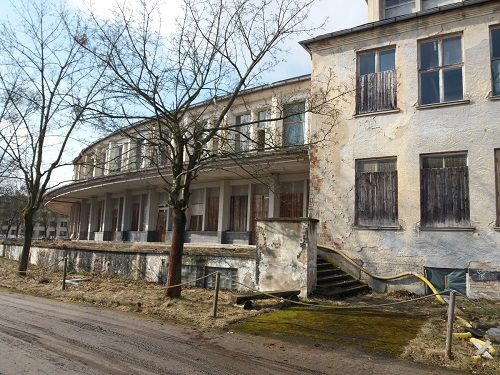
The Speisehaus in 2018, before the conversion into an apartment complex. Source: M.S. Laarman Collection
Almost exactly a year after the end of the Games, the Speisehaus was opened again, but this time as Olympialazarett, the Olympic hospital. Here were the usual spaces such as operating rooms but also something special: on the terrace it was possible to drive bedridden patients with their beds outside. Light, air and sun for a swift cure! It accommodated 150 patients, another 150 and the nursing staff found a place in the cottages.
Today, the Speisehaus is the first large building to mark the resurrection of the Olympic village, but now as a residential area for citizens. It creates luxury apartments with respect for the monumental status. The delivery will be around 2021.
Reception building
The Empfangsgebäude was the largest (4,674 m2) building in the complex. It formed, as the name suggests, the reception area and gave access to the village. It was located next to the Berlin – Hamburg highway. In the middle was the gatehouse, the central and only access to the village. A carillon was placed on the roof, which played the Olympia hymn composed by Richard Strauss every hour. It also graced the cover of the booklet Dorf des Friedens (Peace Village), published for the residents of the village.
There was a circular wing on both sides of the gate. In the west wing there were spaces for luggage, customs, laundry acceptance, telephone exchange, the athlete’s office and five stores. In the east wing was the reception hall, an office for the village commander, a Hoffmann-Retschlag restaurant with a terrace for visitors from outside the village and housing for staff. The most important space was the 'Halle der Nationen' (Hall of Nations). Here every participating country had a counter, and visitors were also allowed to come from outside, as the village itself was closed to outsiders. For example, they could phone every house in the village and meet in the restaurant or the Hall of Nations.
Each time an Olympic team arrived in Berlin, the reception went according to a fixed ceremony. After arrival and greeting at the train station, a welcome speech followed at the Rotes Rathaus (red town hall), after which the athletes were taken to the Olympic village by bus. A welcome ceremony was held here at the Empfangsgebäude, with a speech from the village commander, flags and the national anthem of the visiting country played by the village chapel. Then they went in a procession with the chapel, commander and other escorts to the houses where the athletes would stay and they were handed the keys.
In a bombing raid on April 20, 1945, the east wing was severely damaged. After the war, building material was used to renovate houses in the neighborhood. The remains were probably demolished around 1953. Remains of the tunnel under the highway remained visible until 2011, until they also disappeared during road works.
HindenburghausThe 2,229 m2 large Hindenburghaus was the focal point of the 'Geselliges Dorfleben', the cozy village life. During the Games there was a theatre hall, training rooms, spaces for the international sports organizations, medical establishments, hairdressing salons and office spaces with typewriters in all common languages and different alphabets. In the evening one came together to be entertained with cabaret, music, dance, film, etc. On Sundays there were church services.
The Dutch newspaper De Telegraaf of May 8, 1936 wrote: "Furthermore, there is the Hindenburghaus, which contains a theatre hall, in which during the Games each evening will be film, variety and cabaret, while the wings will be destined for the international hairdressers and foreign doctors. One cannot let a Musselman get shaved by a Berlin Protestant hairdresser, while a sick Japanese will preferably want to be examined by a fellow countryman."
The name of the building was not chosen without reason. Generalfeldmarschalk Von Hindenburg was state president from 1925 to 1933 and patron of the Olympic Games until his death in 1934. Two quotations from him can be found on the façade, but these are only vaguely visible nowadays. They read:
Ich Baue fest auf dich, Deutsche Jugend(I build upon you, German youth)
and
Die Treue ist das Mark der Deutsche Ehre
(Loyalty is the Mark of German Honor)
Above the entrance the Hindenburg family coat of arms could be found, but that has now been covered by planks. On the second floor a large relief is visible in honor of Von Hindenburg: marching Wehrmacht soldiers. The design of the relief is by Wilhelm von Ruckteschell, a writer, illustrator and sculptor. He is also known for another work of art which is now controversial and tucked away: The Deutsch Ostafrika Ehrenmal in Hamburg. In the Russian era, the relief was hidden under a thin layer of cement but has been made visible again quite recently. Opposite the relief stood a bust of Von Hindenburg.
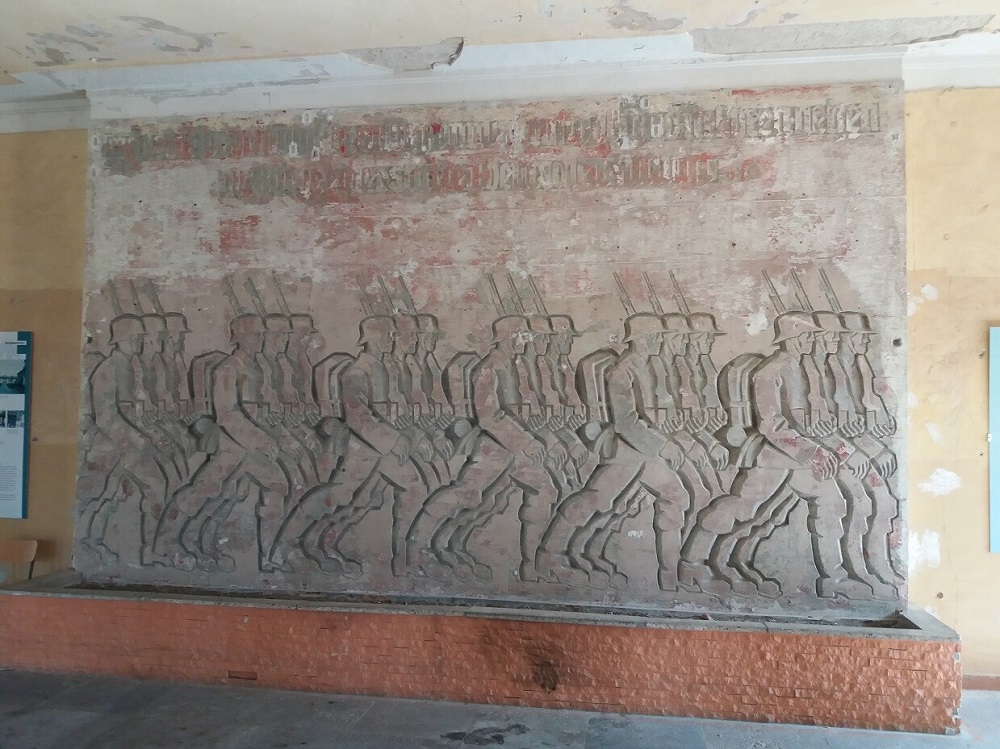
Stone relief in the Hindenburghaus depicting marching Wehrmacht soldiers. Source: M.S. Laarman Collection
It is the only place where you can see on the same wall on one side marching Wehrmacht soldiers in stone relief, and on the other side of the wall a drawing of Lenin. This reflects the irony of German history, from pompous power in the Third Reich period, to the defeat and following occupation by an enemy regime. And then just by one of the countries that was attacked by the Wehrmacht and also played a large role in the fall of the Third Reich. They did not participate in the Olympic Games. Their first appearance was in 1952.
There also was a room with a then sensational and new invention: Television! There was a Fernsehstube, a room where one could watch television. In 1936, television was still a very distant future. The Olympic Games were broadcasted live, as one of the first events that one could follow on television. It was in black and white and on small screens, but it was a remarkable novelty. In those years the radio was just emerging as a mass medium. TV broadcasts were rare, and could only be seen in specially equipped rooms (Fernsehstuben), which were found in several cities. In the Olympic village the athletes who at that time had the opportunity in the Hindenburghaus could follow the Games almost live. For many of them, this would have been their first experience with the new medium.
Swimming pool
The swimming pool (Schwimmhalle) measures 12 by 25 meters and has two springboards at 2- and 3-meters height. There were also a sauna, bathtubs, massage rooms, hairdresser and changing rooms in the building. The most special is the glass window on one of the long sides of the swimming pool, which can be raised electrically so that the bath is open. A special feature, then and even now. The heating was done with what we now call district heating, which at the time was also very modern, but the Russians did not get it working and never used it. In 1993 a fire destroyed the roof of the building and after that it was largely inaccessible. In 2011 the roof and the roof covering were repaired. Although the building nowadays mainly makes a desolate impression, it is still easy to imagine what it looked like in the heydays.
Home of the Commander
The Commander, first Wolfgang Fürstner, later Werner von Gilsa had a service home on the property. It was a simple two-story building. Fürstner spent his last hours here before committing suicide near the pond behind the house. During the Russian occupation it was used as a daycare center. Nowadays it is empty.
Sports hall
Opposite the swimming pool is the sports hall, which at that time contained a boxing ring and gymnastic equipment. Special is the front with glass doors. Between the hall and the swimming pool was and still lies an athletics track with the same dimensions as in the Olympic stadium. Currently there is a small exhibition about the Games and the terrain.
Athletes’ homes
There were 141 homes for athletes and their caregivers, five of them with two floors. These had eight to twelve bedrooms for two people, a room for the steward at the entrance, bathroom with shower, and very special for that time: a phone. At the end of the building there was a 'Gemeinschaftsraum', or the common room. Each house was named after a German city, and the coat of arms or emblem of that city was visible next to the entrance. In addition to being a promotion for Germany, it was also easier for athletes to find their accommodation there. The theme also came back in the common room, where murals of the city concerned were applied, in the photos that were hung up and on the bedding and towels. The cities in question were asked to bear the costs of this, and/or to supply the material mentioned.
As far as the Dutch are concerned, the distribution was according to the Venlo newspaper of July 29, 1936: "21 cyclists plus the Dutch cook are staying in the house ‘Neustadt’, two cyclists and 16 athletes and 4 pentathlon athletes are housed in ‘Kaisers Lautern’, 11 boxers and 11 swimmers were able to live in ‘Baden’, 13 fencers, 7 swimmers and Dr. Van Daal in ‘Constanz’ and finally the 19 hockey players and the chief of mission, Mr. Lotsy, stayed in ‘Freiburg’ in the coming days 108 Dutch people will live in the Olympic village."
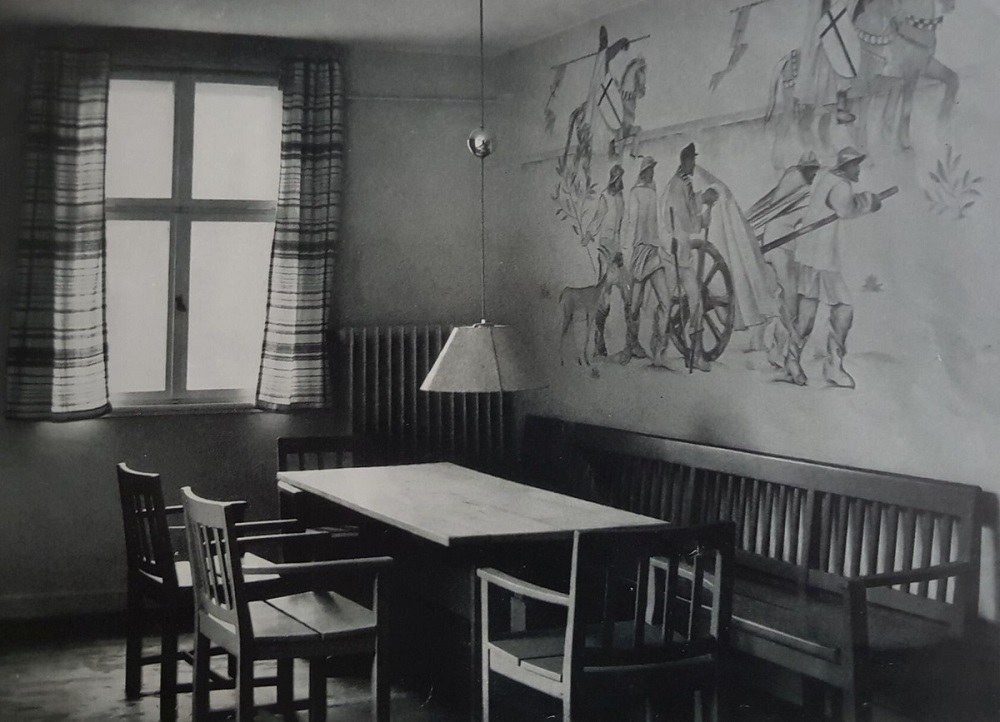
Every house contained a Gemeinschaftsraum or common room. The drawings on the walls referred to the name giver. Source: Dorf des Friedens, 1936
They were very pleased with the care. This was reflected in large matters, such as a steward per cottage who provided all kind of services, but also in the smaller cases. On August 26, 1936, for example, what we would now call an advertorial, the newspaper Graafschapbode writes: "Perhaps it is known that every group that participated in the Olympic Games had its own cook. He ensured that the prescribed diet was strictly followed. But it is lesser known that the concerns of the Olympic Committee for the prosperity of the participants even extended to the type of soap used in the Olympic village! Great care has been taken by choosing a soap that does not irritate the skin but keeps it fresh and supple. As is well-known during the Greek Olympiads, the athletes were massaged with olive oil. And so, every inhabitant of the Olympic village found a piece of Palmolive soap in his cabin, containing a large quantity of olive oil. In a time where taking showers of bathing was less common than now, it sure was a pleasant luxury!"
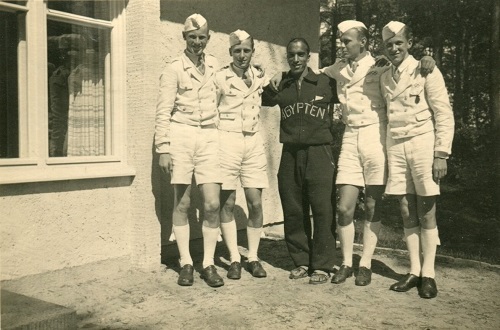
The Egyptian basketball player Mohamed Rashad Shafshak with supervisors from the Ehrendienst. 185 boys and 70 girls were appointed to accompany the athletes. They guide them in the village and town, during training and were said to be highly motivated and appreciated. Source: M.S. Laarman Collection
Of course, there also had to be medical care. There were constant medical staff present. Five doctors and forty nurses worked in shifts. Haus Hanau was their post. Not only could they perform minor surgery, they also monitored hygiene in the kitchen, swimming pool and other facilities.
After the war, most of the houses were demolished by the Russians. There are still twenty homes left in different states of decline in 2019, one of which has been set up as a museum and furbished like it was in 1936.
Bastion & Sauna
The Bastion no longer exists today. In fact, it was a bit of an exaggerated name for an idyllically located open-air bar on wooden posts and with a thatched roof. The villagers could gather here for a drink, as long as it wasn't alcohol. Next to it was a deepened section, designated in the terminology of the time as Thingplatz. Here the village orchestra played its daily tune during the Olympiad. In 1944 the building was damaged by a crashed English plane and demolished afterwards.
Another building was the sauna. It was a simple wooden building, idyllically situated on the banks of a lake. In those days, taking a sauna was not as common as it is today, so the 'Finnische Dampfschwitzbad' (Finnish steam bath) attracted attention.
Entrance ticket Haus Zittau
In 1936 a certain Mr. Smith made a trip through Germany. It's unknown if he was a journalist, or it was just a private trip. He pasted his tickets into an album. He visited the village on August 7 and had an admission ticket for house number 100, Haus Zittau. This was one of the cottages where the American athletes stayed, and which miraculously still exists.
Definitielijst
- brigade
- Consisted mostly of two or more regiments. Could operate independently or as part of a division. Sometimes they were part of a corps instead of a division. In theory a brigade consisted of 5,000 to 7,000 men.
- raid
- Fast military raid in enemy territory
- Wehrmacht
- German armed military forces, divided in ground forces, air force and navy.
Persons
Empty buildings are, of course, only stone casings without the stories of the people who stayed there. There are a few special stories to tell about this village.
One of the houses is furnished as a tribute to Jesse Owens, the American black athlete who won four gold medals. He was popular in Germany, but not always treated well in America.
On the other hand, there was Wolfgang Fürstner, a convinced National Socialist and commander during the construction of the village, but he committed suicide in the village. Why? More information further on in this article.
Then there is the Dutchman Karel Lotsy. He was the chef d'équipe during the Games, had a resounding career in the sports world and was a great motivator. Then suddenly, years after his death, he is accused of having been on the wrong side during the war. Justified? On this website, two books have been reviewed which delve deeper into this subject: ‘De Dordtse Magiër’ by Frank van Kolfschooten and ‘Een sportman doet niet aan politiek’ by André Swijtink.
More special facts and persons. Not every winner was happy with his medal. That was the case with the winners of the marathon, for example. The gold and bronze medal were won by Sohn Kee-chung, and Nam Seung-yong. They were from Korea, then occupied by Japan. That also meant that they had to officially stand for Japan, with a Japanese flag on their clothing, under a Japanese name. Their victory was attributed to Japan, not Korea. The athletes themselves were not happy with this. That is also clearly visible in their looks and attitude on the stage photos. In interviews, Sohn talked about the occupation by Japan, but that was not picked up by the interpreters and media. In the homeland there was a newspaper that posted a photo of Sohn, with the Japanese flag on the shirt removed. That was not appreciated, eight newspaper employees ended up in prison and the newspaper was not allowed to appear for at least eight months.
Fortunately, justice came later. At the 1988 Olympic Games in Seoul, Sohn was the torchbearer during the opening ceremony. In 2011, the IOC decided to do justice to the winner and to place a footnote on his name. His real name was Sohn Kee-chung, not the Japanese Kitei Son.
The list of athletes who died during the Games is fortunately not very long. Yet there was one in 1936. The lightweight boxer Nicolae Berechet died four days after his lost match in Berlin. The official cause was blood poisoning from improperly healed boils. He was buried in Berlin and not brought back to his native Romania.
The current visitors follow in the footsteps of the 1936 athletes, but also in the footsteps of a long list of famous people who have visited the village. Charles Lindbergh, Max Schmeling, Rudolf Hess, Joachim von Ribbentrop, Adolf Hitler, and artists such as Zarah Leander, Johannes Heesters and Marika Rökk.
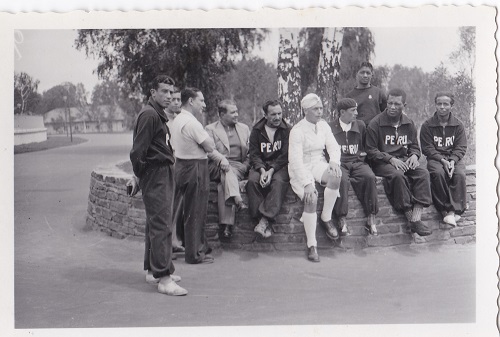
Athletes from Peru in front of the restaurant. That land debuted in 1936 with seventy-four athletes. Source: M.S. Laarman Collection
The debut of Peru was not without commotion though. After a 44-day boat trip, football players, boxers, cyclists, a basketball team and fencers arrived in Germany. Football was the sport that was very popular the most at the time, and the Peruvian team impressed with their play and results. On August 8, they played against Austria in the quarterfinals, which ended in a 2-2 draw after 90 minutes of playing. What happened in the extension is not exactly clear. The game ended in 4-2 for Peru, but Austria protested. Peruvian fans would have come onto the field, and the players would have mistreated Austrian football players. The FIFA and the IOC gave the opportunity to play the match again on August 10, now without an audience. However, the Peruvians did not show up because they had learned too late that they had to play again, and the players were unable to leave the village, because a cycling race was blocking the road. Austria was then declared the winner of the competition. That led to a lot of turmoil. The teams of Peru and Colombia felt compromised in their honor and immediately left the Games. In Peru itself, Germany was seen as the culprit and German companies, banks and the consulate were pelted with stones. There were demonstrations and riots. The other South American countries also expressed their support for Peru, but did not go so far as to leave the Games. This was a very undesirable situation for Germany. They wanted good ties with these countries, but now the Games had driven a wedge between relations. The Peruvian Olympic team returned to the country on September 17, 1936. That day was declared a national holiday by the president and the players were welcomed as heroes. Very remarkable without winning a medal …
Wolfgang Fürstner
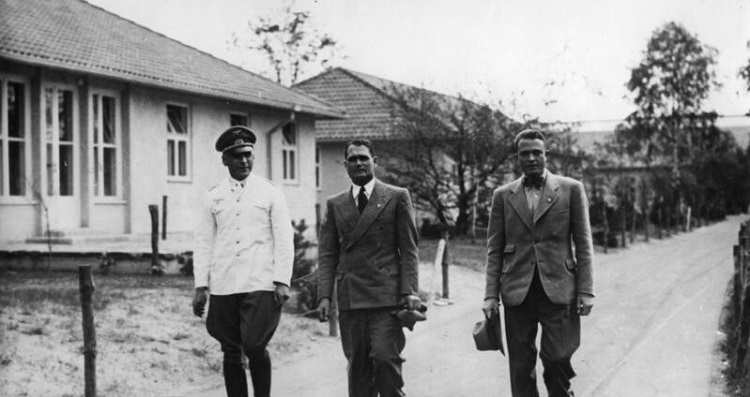
From left to right: Wolfgang Fürstner, Rudolf Hess, Hitlers deputy as head of the NSDAP, and his adjutant Alfred Leitgen during a visit to the village. Source: Bundesarchiv, Bild 183-2008-0122-501 / CC-BY-SA 3.0
On August 21 one could read in the Nieuwsblad van Friesland:
German Olympiad Tragedy
When the Olympic village was set up in Berlin, a certain captain Wolfgang Fürstner was appointed as its commander. It did not take long, however, for he was constantly attacked in certain National Socialist circles with the accusation that he was of Jewish descent. Even notes were posted in the vicinity of the Olympic village which said: "Away with the Jew Fürstner". Gradually the attacks became so violent that another commander was appointed on the eve of the Games. Now comes the tragic news that Captain Fürstner has taken his own life with a gun shot.
Wolfgang Fürstner was a convinced National Socialist and commander during the construction of the village. Under his leadership the village was built and the organization set up. After the start of the Games a higher-ranking officer took his place. This was Werner Freiherr von und zu Gilsa, previously commander of the Wachtruppe Berlin.
Everyone at home and abroad was enthusiastic about both the village and the Games. Then one would expect: a good career is ahead for him. However, that turned out not to be the case. It was discovered that his great-grandfather was Jewish, who later converted to Christianity. That made him partly Jewish, and as we know, people were not very fond of it at the time in Germany. As a result, he was no longer allowed to be a commander, his colleagues avoided him, he was no longer considered full and certainly not Aryan. He realized that he would also be expelled from the Wehrmacht. And what would happen to him afterwards?
His marriage didn't go too well either, his wife wanted to divorce. Perhaps there were some other disruptive private circumstances as well. The fact was that, now that it turned out that he was not without "racial shame", he saw no other way out than to take his life with a gun. He did this on August 18, while the last athletes were still in the village, behind his house and next to the lake in the Olympic village.
To put it in perspective: the Olympics were over and a great success. Germany had left a positive image with most visitors. Not much had been noticed about the persecution of the Jews. And then suddenly this suicide, even
Dutch and other foreign newspapers reported Fürstner had committed suicide. In the German press at that time people were not so open, calling it an accident, a heart attack, or simply kept silent about the cause.
Normally the rules were such that a soldier who had committed suicide was treated with little regard. There would be no ceremony, and the grave had to come in a separate corner, not with the other soldiers who had been killed with honor in battle. Fürstner, however, was buried with military honours. On Saturday, August 22, he was buried in the Invalidenfriedhof in Berlin Mitte, a privilege for prominent figures in the Third Reich. You can also tell when you have a look at other persons who were buried there, such as the Luftwaffe ace Mölders, Heydrich, Fritz Todt and many others.
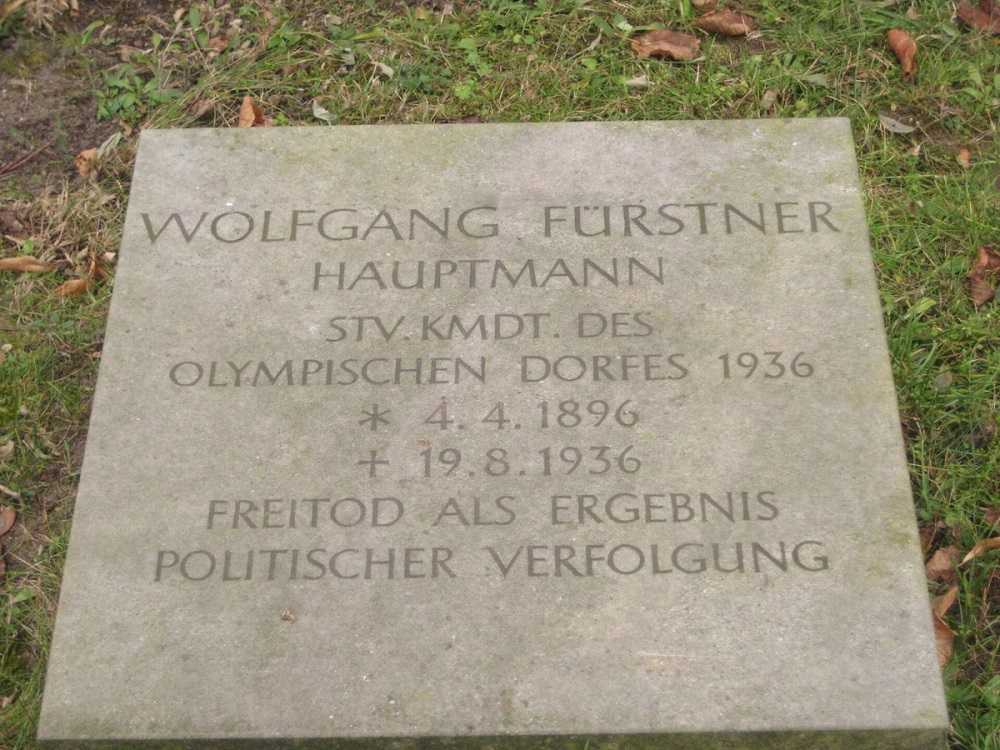
The gravestone placed in 2002 for Fürstner at the Invalidenfriedhof, Berlin. On the stone the text: Freitod als Ergebnis politischer Verfolgung (Suicide as a result of political prosecution). Source: Beek100 / Wikimedia Commons
The events surrounding Fürstner are examples of the nonsense that was being said about skin color and origin. Wolfgang Fürstner was not judged by what he had done for his country, and what value he had as a person. Only the origin counted, with many destroyed human lives and misery as a result.
Experiences
But what did the athletes themselves think about the village and the Games? We have the memories of an Olympia participant from Liechtenstein. That country participated in the Olympic Summer Games with six men for the first time in 1936. Just like most of the participants, they were very impressed. The story begins with the arrival in Berlin.
After the solemn greeting at the Anhalter Bahnhof, we took a seat in a military bus and drove through the festively decorated streets of the city of Berlin. Every time the bus passed by an interesting building or monument, Herr Baron Woldemar von Falz-Fein informed us of this. Although we were really tired, we kept our eyes open because we didn't want to miss anything. After a one-hour drive we finally arrived at the Olympic village. When we arrived, we were enthusiastically received by a large crowd. A senior Reichswehr officer gave a brief greeting and afterwards, while the national anthem was being played, our beloved flag was raised. This event was so solemn and overwhelming that the eyes of every one of us became moist. After this ceremony, the gate, which separates the Olympic village from the outside world, was opened and we made our solemn entrance to the village of peace. A military chapel was at the forefront, furthermore there were a number of participants who had arrived before us.
Arrived at the Limburg house, where we were to camp, the Liechtensteiner national anthem was played again and the blue-red flag was hoisted on the flagpole in front of the house. But the pleasant surprises were not over yet. We were all delighted when we were shown the clean and friendly living rooms. Each had two beds, two wardrobes, a table and chairs. Most of the houses had fourteen such rooms and furthermore a larger living room and laundry and bathroom. Our crew did not need the entire house by far, so a few Greeks and French were also housed with us.
Although we were a very international group, everyone felt very much at home there. Our Hauswart (janitor) was a very cheerful friend. He is a sailor and could therefore tell us exciting stories for hours. Incidentally, the entire staff was like that: they had all seen something of the world and were familiar with the other customs and habits of other peoples.
When we had put away our things, we went straight to the restaurant, our stomachs were grumbling. Our Ehrendienstoffizier, Hauptmann von Rhaden, ensured that our stomachs were filled quickly. Every larger country had its own space in the Wirtschaftsgebäude. The delegation from Liechtenstein was of course too small to want to have its own room, so that we shared a place with the people of Luxembourg. Immediately at the first meal we could see that the menu was so well filled that even the most spoiled connoisseur came into his own.
After lunch we wandered through the village. We could see with the care and attention that everything was arranged to make the stay as pleasant as possible for the foreign guests. An idyllic pond was dug, trees moved and the former moor became a paradise.
On August 28, 1936, back home, he wrote:
Continuous watching the matches in the stadium had made us tired and we enjoyed returning to the quiet, peaceful village in the evening. However, it also happened that a large crowd of signature hunters were waiting for their victims in front of the entrance gate, and then you were not just gone until you could finally enjoy the long-awaited rest. The best experience during our time in Berlin was that when the prince of our noble royal family visited us in the village and could convince himself that we were really well accommodated.
This is how each day passed. When the Olympic Games were over, the moment of farewell also came for us. A well-known saying goes: Es ist nichts schwerer zu ertragen, als eine Reihe von guten Tagen (Nothing is harder to bear than a series of nice days), but in our case that was not true, because we could hold on for a long time. When we browse through the books about the Games and the village we were given, the memories came back to life vividly. We are grateful to those who made it possible for us to participate in this Olympiad.
So far the memories of a participant from Liechtenstein.
Women
In the Dorfbote, a newspaper for the residents of the village, there was a competition: Why is the Olympic village called the Dorf des Friedens (village of peace)? A Finnish participant won the prize with his answer: because there are no women.
Whoever does a Google search for the word 'Olympic village' will soon come up with messages about another record of condoms that was handed out to the athletes, or the parties afterwards. In 1936 people were not so open and free. There was a strict separation between men and women, the latter were not welcome in the village. The 331 female athletes and their supervisors were housed a few kilometers away in a student house at the Reichssportfeld and a gymnastics school. Even during the open day for the press on July 30, 1936, no female press representatives were allowed to be present, and the entire kitchen and service staff in the restaurants also consisted of men. The only woman allowed to stay in the village was the wife of Kommandant Fürstner who lived with him in the house on the property. If the athletes wanted to see women during their stay in the village, the only option was to go to the city, or to the reception building where women did work or came as visitors.
It would take until the 1956 Games in Melbourne for men and women to stay together in one Olympic village, although then separated by a fence.
Definitielijst
- Jews
- Middle Eastern people with own religion that lived in Palestine. They distinguished themselves by their strong monotheism and the strict observance of the Law and tradition. During World War 2 the Jewish people were ruthlessly persecuted and annihilated by the German Nazis. . An estimated 6,000,000 Jews were exterminated.
- Luftwaffe
- German air force.
- persecution of the Jews
- "Judenverfolgung", action imposed by the Nazis to make life hard for the Jews, to actively persecute them and even annihilate them.
- Wehrmacht
- German armed military forces, divided in ground forces, air force and navy.
Photo album
The pictures in this chapter come from a photo album that had belonged to a Wehrmacht soldier deployed as telephone operator in the Olympic village. He had the opportunity to walk around the village and take pictures. His daughter was born during his stay there. His wife was kind enough to send a card with the happy message and a photo.
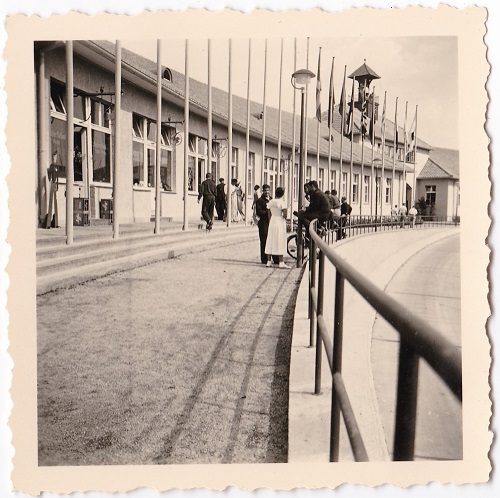
In front of the main entrance. There were several shops which could also be visited by non-residents of the village. Some athletes talk with a lady Source: M.S. Laarman Collection
Definitielijst
- Wehrmacht
- German armed military forces, divided in ground forces, air force and navy.
After the Games
After the last teams from Brazil, China, Chile and Uruguay had left on August 20, 1936, the village got its second destination: barracks and military hospital.
From December 1936, the new residents of the 'most beautiful barracks of the world', as it was called, were an infantry school and the 1. Battalion of the Infantry training school. The staff used the reception building, the main hall of which became the officer's mess, the infantry school used the Hindenburghaus. The restaurant became the Olympialazarett, the athletes’ houses became the residence of the hospital staff, the soldiers and participants in various training courses. Not much can be said about the Wehrmacht period, it was the usual course of events as in most barracks and hospitals. Soldiers were trained, patients healed.
There was another important moment in the war in which the village played a minor role. On July 20, 1944, an assassination on Hitler and his staff took place by Claus Schenk Graf von Stauffenberg, which was followed by a coup d’état. A unit of the infantry school occupied the Funkhaus (broadcast station) on the Masurenallee in Berlin. Radio broadcasts were provided from here, and were therefore an important medium for the old and new government. Major Jakob's job was to stop the radio broadcasts, but he lacked technical knowledge. As a result, the broadcasts continued as usual. And so, this small but oh so important part of the coup failed, just like the coup itself.
Although nearby Berlin was bombed countless times and was also under artillery fire in the last phase of the war, the village had largely been spared the violence of war. Still, on April 20, 1945, stray bombs from an Allied bombing on the nearby marshalling yard Wüstermark caused damage. Some houses and the east wing of the reception building were badly damaged.
From April 1945 it was clearly noticeable in the hospital that the final battle for Berlin was going on: many wounded found their way to the Olympialazarett.
What happened in the rest of eastern Germany also happened in the village on April 22 – the Russians arrived. The last civilians and soldiers had left the village hastily, the bedridden patients were left behind. The hospital continued to function until July 1945.
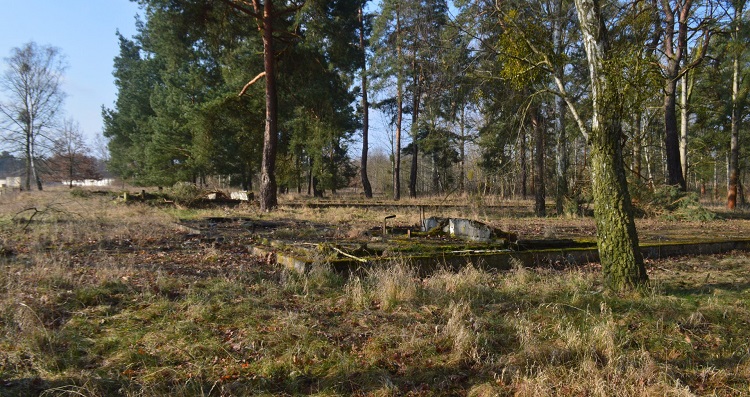
Foundations of houses demolished by the Russians. In August 2019, the foundations including cellars were demolished to make way for new houses and apartments. Source: M.S. Laarman Collection
After the war
After the German capitulation, German refugees and people who had lost their homes in the bombing and battle of Berlin found temporary accommodation in the village. The Russian occupier also used it as a place to live, but only in 1947 did they officially take over. The last refugees left the village in 1949, after which Russian officers and their families came to live there. 121 of the 141 houses were demolished in the seventies and eighties. Instead came the well-known German Democratic Republic Plattenbau: ugly flats. Nowadays, only the hull is left of these flats. A number of them will be demolished, some of them may be made suitable for habitation. The Russians also built a number of new buildings, such as a cafe. This is now also demolished.
After the fall of the Berlin Wall in 1989, a lot changed in Germany. Soldiers with nothing to do, uncertain about their future, and with vodka within reach, sometimes want to demolish something out of frustration. So that also happened regularly. Eventually the Russians left the complex in 1991/1992.
In 1993 the area was granted a protected monument status. But under which municipality the Olympic village and area of the military training grounds at Döberitz actually fell remained a dispute for a long time. Finally, it was decided in 1996 that it belonged to the municipality of Elstal. The terrain was a chaos with wrecks of vehicles and all kinds of Russian leftovers. Hardly any maintenance had been done in past decades. From 1994 onwards the site was cleaned up and most of the furnishings were removed from the buildings. In 2000, the land was sold to a subsidiary of the DKB bank. In the meantime, the buildings increasingly decayed and fell victim to vandalism, such as arson on the roof of the swimming pool and metal gutters and railings in other buildings being stolen.
Fortunately, the DKB took care of the site, carried out necessary maintenance and made it accessible to visitors during guided tours.
As with all buildings, vacancy is decline. The best way to preserve monuments is to give it a function. The site of the Olympic village is therefore perfect for redevelopment – not too far from expensive Berlin and in a natural environment. That is what is now taking place. The symbolic first spade for a major project to breathe new life into the site went into the ground in July 2017. The aim is to renovate the Speisehaus der Nationen into 115 homes. Afterwards, another 350 homes will be built on the location of the athletes’ houses demolished by the Russians. Those who still want to see the village in its current state have to hurry. In a few years it will look different.
Definitielijst
- capitulation
- Agreement between fighting parties concerning the surrender of a country or an army.
- infantry
- Foot soldiers of a given army.
- Wehrmacht
- German armed military forces, divided in ground forces, air force and navy.
Aftermath
The RK Bouwblad (volume 8 number 4, 1936) wrote about the village:
"If we look at the whole after this description, then we can conclude that a great love of nature, a predominant organic attitude and a great unity of thought among architects and decorative artists, have created an ‘Olympic’ village here, which is unique in its nature and very rightfully arouses the admiration of the whole world. Werner Marck has built here in a characterful way, not neutral or international and also satisfying to all."
Athletes from all over the world felt comfortable in the Olympic village. Germany had done its best to accommodate them comfortably in an international fraternity. Unfortunately, that turned out to be a temporary idyll. German Jewish athletes, for example, were largely excluded from the Games, and later from society as a whole. And while the Games were going on, nearly forty kilometres from the village the Sachsenhausen concentration camp was being built. Contrary to the village of peace, Sachsenhausen could be named a village of destruction. The first prisoners arrived shortly after the Games in September 1936. The camp would be in use almost until the end of the war in 1945. This would be one of many locations where the Nazis starved, exhausted, gassed, murdered anything and everyone they didn't like.
The foreplay for the Second World War already started during the Olympic Games. Hitler supported the Spanish general, later dictator Franco by means of transport aircraft, later that was expanded with a larger contingent, including fighter aircraft and bombers. The Kriegsmarine and the Panzertruppe also had an active share. In total around 20,000 German soldiers served in Spain. The soldiers rotated so that experience was gained. That would come in handy in the coming years.
After the Games, soldiers were trained and housed in the Dorf des Friedens. They would soon go on tour to other countries, but not with a peace message.
Three years later, in 1939, it was very likely that the German and Polish Olympic participants would see each other again. Now not in a competition, but a battle for life and death on the battlefield. The other countries soon followed. Of the 49 countries that participated in the 1936 Games, only 11 were able to largely avoid the skirmishes. The remaining 38 actively participated in World War II, either forced or out of conviction. Olympic Games and the acclaimed international brotherhood are no guarantee of world peace.
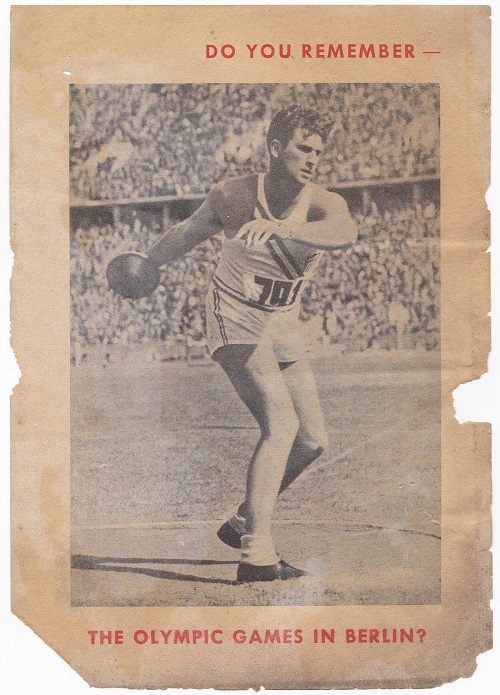
Do you remember … A transparent propaganda attempt. Pamphlet, from 1944 or 1945, intended for American soldiers. An appeal was made to leave Germany alone, because it was actually quite fine, while the Americans were causing death and destruction. Source: M.S. Laarman Collection
Of the German athletes, 202 won a gold, silver or bronze medal. At least thirty of them were killed by acts of war. We do not know exactly how the other countries were doing, but it is certain that many of the young people who took part in the Games in Berlin died during the war.
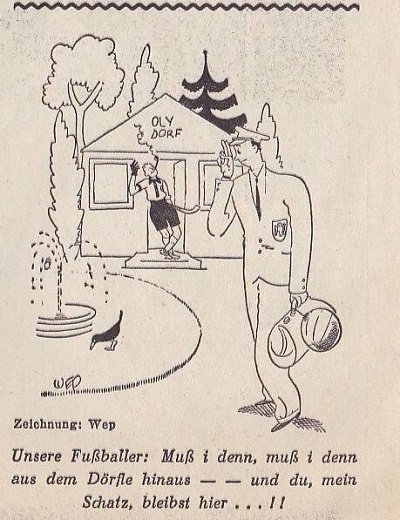
Newspaper image with the chorus of a song. It is a variation of the song Wooden Heart that we know from Elvis Presley. It is already a very old song, it was first recorded in 1827 but is even older. Source: Olympia-Zeitung, August 11, 1936
The beautiful words and ceremonies could almost make you believe that people in Germany respected Olympic athletes. That also proved to be untrue. An Olympic medal was no guarantee that you would not end up in a concentration camp. An example is the Hungarian gold medal winner Kajroly Kajrpajti, who survived the Zavidovo labor camp. Some of the athletes who stayed in the village of piece in 1936 were later housed in another German 'village', but this time one with the aim of their destruction. Examples are the French swimmer Alfred 'Artem' Nakache, who survived Auschwitz, and the Czech Kurt Epstein, water polo player, who even survived three camps.
It is not known exactly how many of the 3,963 athletes who participated in the 1936 Berlin Summer Games actually died in a concentration camp, but I have found a number of examples:
- Fencer Roman Kantor from Poland, died in Majdanek.
- Long-distance runner Jazef Noji from Poland, died in Auschwitz.
- Wrestler Werner Seelenbinder from Germany, beheaded in prison after various camps.
- Water poloist Bogdan Toajovia from Yugoslavia, died in Jadovana.
- Boxer Ernest Toussaint from Luxembourg, died in Hinzert.
- Rower Hans van Walsem from the Netherlands, died in Neuengamme.
- Rider Pierre Versteegh from the Netherlands, died in Saschenhausen.
The village is a wonderful example of a country's capabilities in terms of architecture, landscape design, hospitality and international cooperation and fraternization. You can only ask yourself what else could have been achieved if that line of construction and cooperation were maintained, instead of that of useless desire for power and destruction. A thought to consider.
2036?
Andreas Geisel from the German Olympic Sports Confederation launched the idea that Berlin could bid for the Olympic Games of 2036. But as everything with regards to history in Germany, this evokes discussion. One could say, there are many good reasons to host the Games, to show the world Germany has learned from history and is not the same country as in 1936. Others see it as celebrating the anniversary of an abused event.
Definitielijst
- concentration camp
- Closed camp where people are being held captive that are considered to be anti- social, enemies of the state, criminal or unwanted individuals. These groups mostly do not get a fair trial or are condemned to doing time in a camp.
- Kriegsmarine
- Germa navy. Part of the Wehrmacht next to Heer and Luftwaffe.
Information
- Article by:
- Maurice Laarman
- Published by:
- George Möller
- Published on:
- 30-01-2022
- Feedback?
- Send it!
Related sights
Sources
- Erlebnisse der Liechtensteiner Olympiamannschaft in Berlin, 1936.
- Official report XI Olympic games Berlin 1936, Wilhelm Limpert, 1936.
- Olympia-Zeitung, nr. 1 - 30, 1936.
- DOST, S., Das Olympische Dorf 1936 im Wandel der Zeit, Verlag Bernd Neddermayer, 2004.
- EMMERICH, A., Olympia 1936, Edition Fackelträger, 2011.
- HüBNER, E., Olympia in Berlin, Morisel Verlag, 1917.
- HüBNER. E., Das Olympische Dorf von 1936: Planung, Bau und Nutzungsgeschichte, Verlag Ferdinand Schöningh GmbH.
- KOPP, R., Wolfgang Fürstner (1896-1936): der erste Kommandant des Olympisches Dorfes, Verlag Peter Lang GmbH, 2009.
- SAALBACH, H., Dorf des Friedens, das Olympische Dorf, 1936.
- WALLAG, G.H. & WERFF JR., G.E. VAN DER, Hoe wij Berlijn zagen, 1936.
Presentation
- Staatsstreiche in historischer und kriminologischer Sicht, Wolf Middendorf, de Gruyter, Berlin 20 juli 1988
Movies & documentaires
- Der Traum von Olympia, 2016, about the commander Fürstner of the village and the Jewish high jumper Gretel Bergmann who in the end was not allowed to participate.
- Olympic pride, American Prejudice: a documentary about the black USA athletes.
Links
- The Olympic village: berliner-zeitung.de
- Repurposing of the Olympic village: rekonstruktionsdenkmal.de
- Korean marathon runners: spiegel.de
- Hitler and Jesse Owens: www.tracesofwar.nl
Thanks to:
- AGON SportsWorld GmbH, where Maurice Laarman bought a number of documents.
- Andy, for scans of a 1936 booklet.
- Jan Bejsovec, guide in the village, who kindly answered many questions of Maurice Laarman and helped him with photos.
- Paul van Gool of the Athletics Historians website for some photos and other information.
